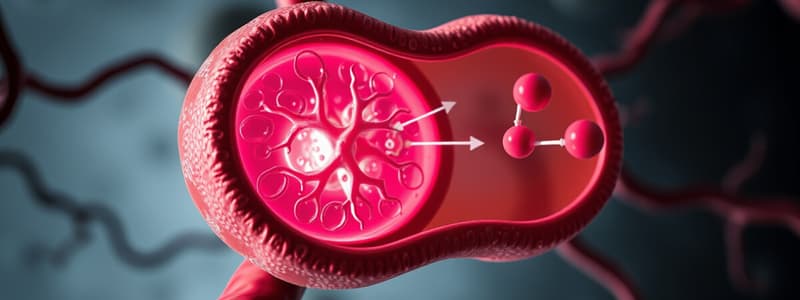Podcast
Questions and Answers
What are the 3 phases of the cellular respiration process?
What are the 3 phases of the cellular respiration process?
Glycolysis, the Krebs Cycle, and the Electron Transport Chain.
Where in the cell does the glycolysis part of cellular respiration occur?
Where in the cell does the glycolysis part of cellular respiration occur?
Cytoplasm
Where in the cell does the Krebs (Citric Acid) cycle part of cellular respiration occur?
Where in the cell does the Krebs (Citric Acid) cycle part of cellular respiration occur?
Mitochondria
Where in the cell does the electron transport part of cellular respiration occur?
Where in the cell does the electron transport part of cellular respiration occur?
How many ATP (net) are made in the glycolysis part of cellular respiration?
How many ATP (net) are made in the glycolysis part of cellular respiration?
In which phase of cellular respiration is carbon dioxide made?
In which phase of cellular respiration is carbon dioxide made?
In which phase of cellular respiration is water made?
In which phase of cellular respiration is water made?
In which phase of cellular respiration is glucose broken down into pyruvic acid?
In which phase of cellular respiration is glucose broken down into pyruvic acid?
What would happen to the cellular respiration process if the enzyme for one step of the process were missing or defective?
What would happen to the cellular respiration process if the enzyme for one step of the process were missing or defective?
The Krebs cycle occurs in the...
The Krebs cycle occurs in the...
Which process is anaerobic?
Which process is anaerobic?
Write out the products and reactants of cellular respiration.
Write out the products and reactants of cellular respiration.
What is the significance of oxygen in cellular respiration?
What is the significance of oxygen in cellular respiration?
What is oxygen's role in cellular respiration? What happens to oxygen when the reaction is over? And what step of respiration does this occur in?
What is oxygen's role in cellular respiration? What happens to oxygen when the reaction is over? And what step of respiration does this occur in?
Why can't fermentation be used for primary energy production by cells?
Why can't fermentation be used for primary energy production by cells?
Compare and discuss how cells store energy and release energy using ATP.
Compare and discuss how cells store energy and release energy using ATP.
Compare lactic acid fermentation and alcoholic fermentation by describing what pyruvic acid is changed into.
Compare lactic acid fermentation and alcoholic fermentation by describing what pyruvic acid is changed into.
Flashcards are hidden until you start studying
Study Notes
Cellular Respiration Overview
- Cellular respiration comprises three phases: Glycolysis, Krebs Cycle, and Electron Transport Chain.
Glycolysis
- Glycolysis occurs in the cytoplasm, breaking glucose down into pyruvic acid.
- Produces a net gain of 2 ATP molecules.
- It is an anaerobic process, meaning it does not require oxygen.
Krebs Cycle (Citric Acid Cycle)
- Takes place in the mitochondria, producing carbon dioxide as a byproduct.
- ATP, NADH, and FADH2 are key energy carriers generated during this phase.
Electron Transport Chain
- Located in the inner mitochondrial membrane, where water is produced.
- Oxygen is essential for this phase, facilitating the efficient breakdown of glucose.
- Hydrogens from glucose combine with oxygen to form water vapor.
Importance of Oxygen
- Oxygen is critical for maximizing energy production in cellular respiration.
- Without oxygen, the process switches to less efficient fermentation.
Fermentation
- Two types: Lactic acid fermentation and alcoholic fermentation.
- Lactic acid fermentation produces lactic acid, occurring in animals under intense activity.
- Alcoholic fermentation converts pyruvic acid into ethanol and carbon dioxide, occurring in plants and some bacteria.
Energy Storage and Release
- Cells store energy in the high-energy bond between the second and third phosphate groups of ATP.
- Energy is released when a phosphate group is removed, converting ATP back to ADP.
Enzyme Role
- Each step of cellular respiration requires specific enzymes; a defect in any enzyme disrupts the entire process.
Reactants and Products
- Reactants of cellular respiration: glucose and oxygen.
- Products: carbon dioxide, water, ATP, and hydrogen.
Key Distinctions
- Fermentation processes are inefficient for primary energy production, only providing limited energy in low-oxygen conditions.
- Cells prefer aerobic respiration for greater energy yields from glucose breakdown.
Studying That Suits You
Use AI to generate personalized quizzes and flashcards to suit your learning preferences.




